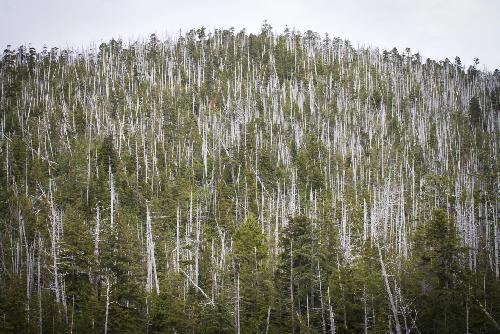A threatened tree species in Alaska could serve as a model for integrating ecological and social research methods in efforts to safeguard species that are vulnerable to climate change effects and human activity.
In a new study, scientists assessed the health of yellow cedar, a culturally and commercially valuable tree that is experiencing climate change-induced dieback and that is found throughout coastal Alaska.
In an era when climate change threatens to touch every part of the globe, the traditional conservation approach of setting aside lands to protect biodiversity may no longer sufficient to protect species.

"A lot of that kind of conservation planning was intended to preserve historic conditions, which, for example, might be defined by the population of a species 50 years ago or specific ecological characteristics when a park was established," said the study's first author Lauren Oakes, a recent PhD graduate of the Emmett Interdisciplinary Program in Environment and Resources (E-IPER) at Stanford's School of Earth, Energy and Environmental Sciences.
But as the effects of climate change become increasingly apparent around the world, according to Oakes, resource managers are beginning to recognize that "adaptive management" strategies are needed that account for how climate change is affecting species now and in the future.
Similarly, because climate change effects will vary across regions, new management interventions must consider not only local laws, policies and regulations, but also local peoples' knowledge about climate change impacts and their perceptions about new management strategies. For yellow cedar, new strategies could include assisting migration of the species to places where it may be more likely to survive or increasing protections of the tree from direct uses, such as harvesting.
Gaging yellow cedar health
The scientists used aerial surveys to map the distribution of yellow-cedar in Alaska's Glacier Bay National Park and Preserve (GLBA) and collected data about the trees' health and environmental conditions from 18 randomly selected plots inside the park and just south of the park on designated wilderness lands.
"Some of the plots were really challenging to access," Oakes said. "We would get dropped off by boat for 10 to 15 days at a time, travel by kayak on the outer coast, and hike each day through thick forests to reach the sites. We'd wake up at 6am and it wouldn't be until 11am that we reached the sites and actually start the day's work of measuring trees."
The field surveys revealed that yellow-cedars inside of GLBA were relatively healthy and unstressed compared to trees outside the park, to the south. Results also showed reduced crowns and browned foliage in yellow-cedar trees at sites outside the park, indicating early signs of the dieback progressing towards the park.
Additionally, modeling by study co-authors Paul Hennon, David D'Amore, and Dustin Wittwer at the USDA Forest Service suggests the dieback is expected to emerge inside GLBA in the future. As the region warms, reductions in snow cover, which helps insulate the tree's shallow roots, leaves the roots vulnerable to sudden springtime cold events.





Comments